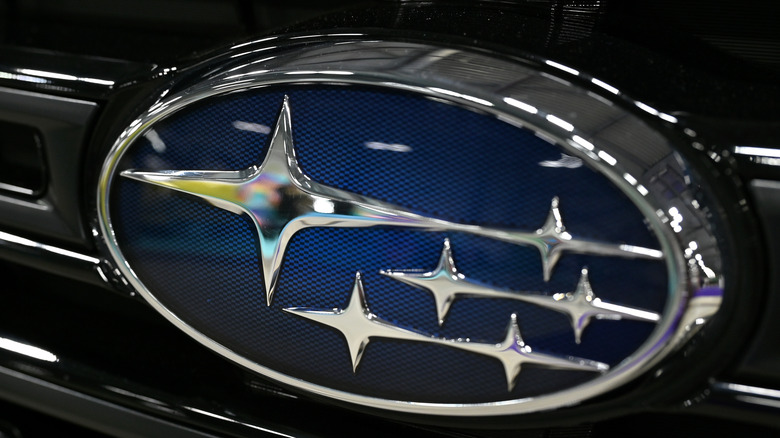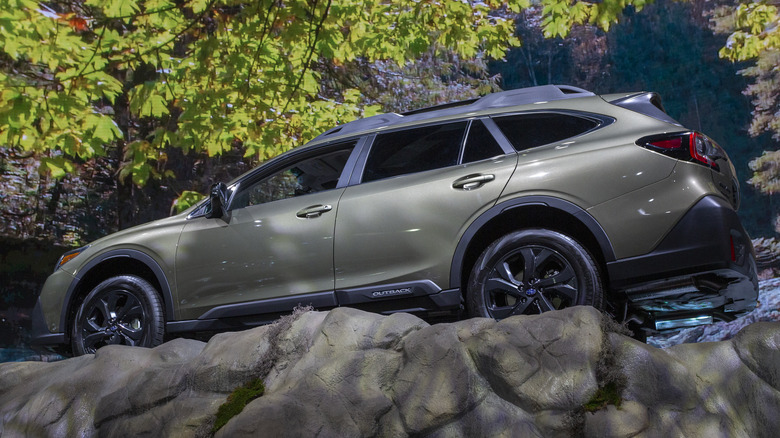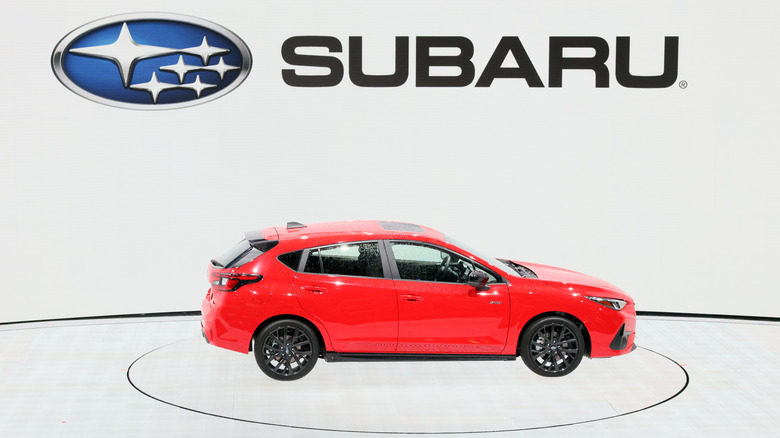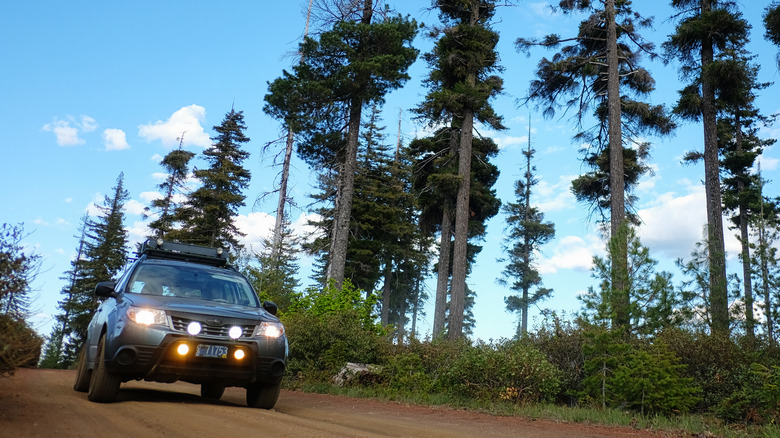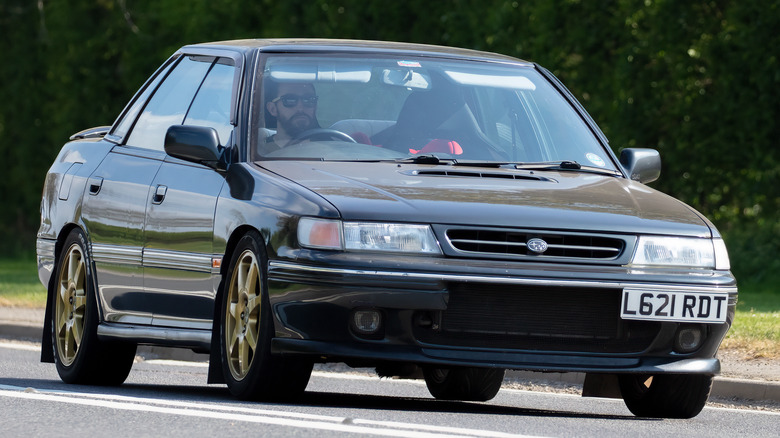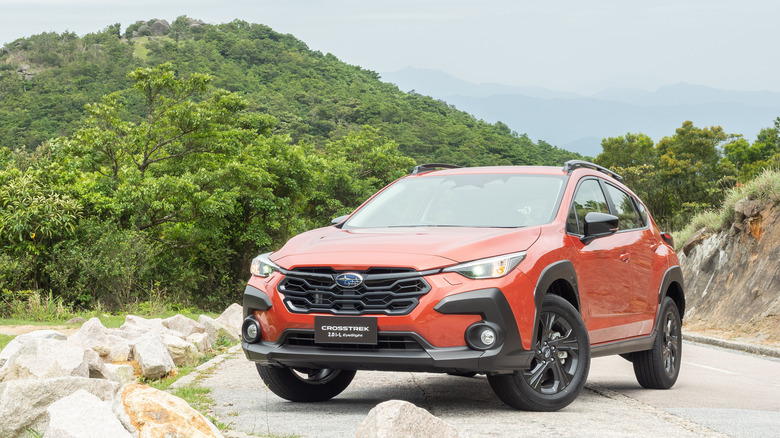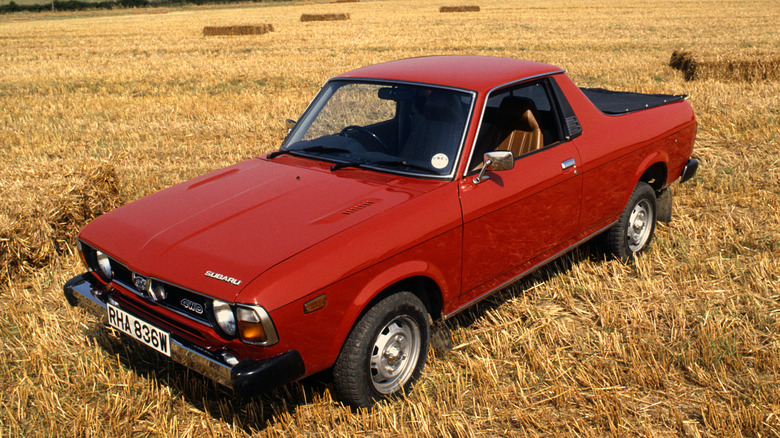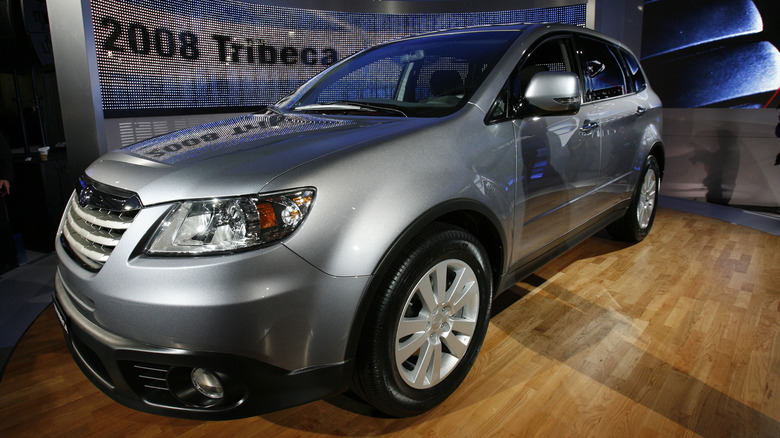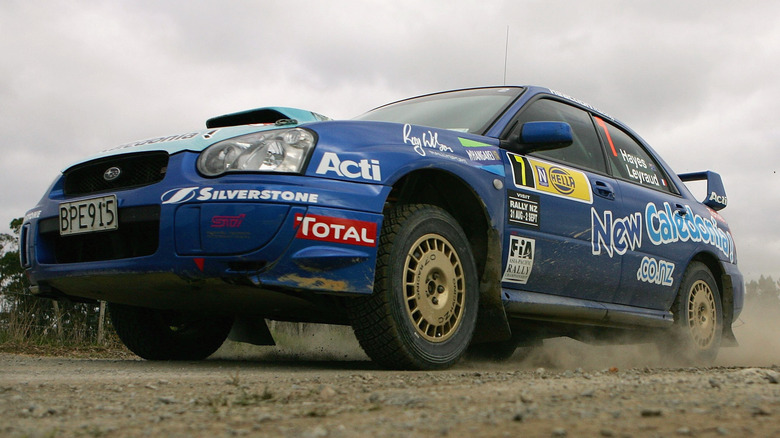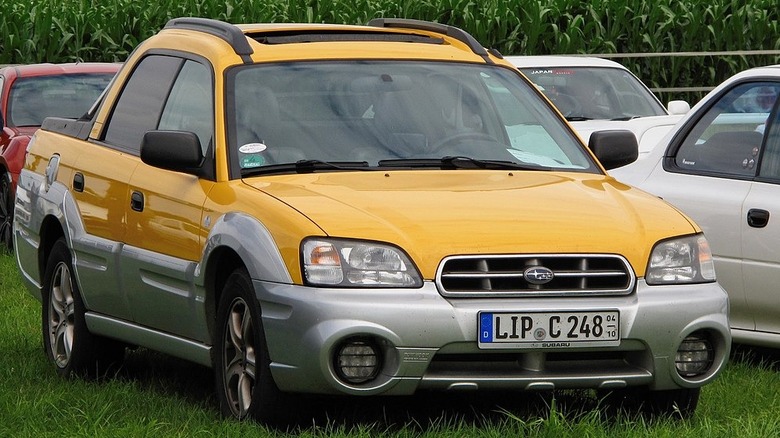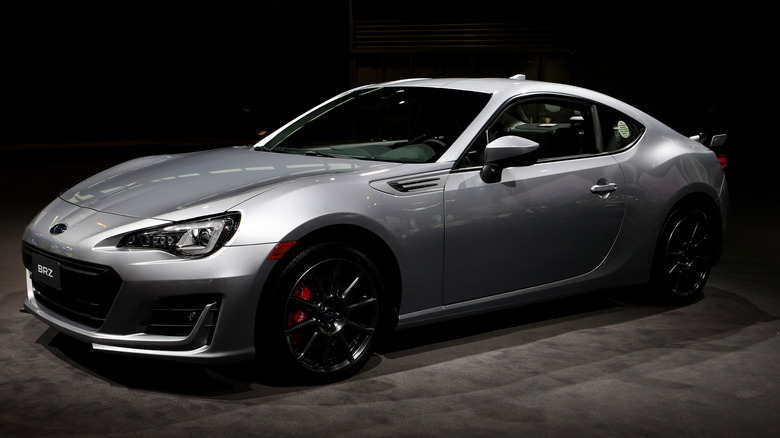The 10 Most Reliable Subaru Models Ever Built
Fuji Heavy Industries, the name you'll see on the metal badge on the driver door of most Subarus, began its life as an aircraft research company in 1915. The company made aircraft for Japan during World War II and, after the war, transitioned into automobile production. In 1968, Subaru introduced its first vehicle to the American market, the Subaru 360, which was literally marketed as "cheap and ugly."
These days, Subaru takes its designs as seriously as its performance. The variety of small-to-midsize cars Subaru offers for everyone, from outdoorsy types to the "Tokyo Drift" crowd, make Subaru owners some of the most loyal in the industry, and that variety of reliable vehicles is one of the reasons customers keep coming back. As of 2022, 96% of vehicles sold in the previous decade were still on the road. As Subaru's car line planning manager Peter Tenn told boston.com, "They love the safety aspect, all-wheel-drive, and that it basically lasts forever in their minds."
With all those Subarus still on the road, it may be tough to determine which are the most reliable. Fortunately, several automotive websites and sales apps have compiled research, which we've used to come up with the following list of the 10 most reliable Subaru models ever built.
Subaru Outback
One of the most recognized Subarus out there and the automaker's all-time best-selling vehicle, the Outback has been the go-to for outdoorsy types since its introduction in 1994 as part of the Legacy Wagon lineup. Reliability is one of the primary reasons folks invest in a Subaru, and the Outback is one of those cars that just seems to live forever with proper maintenance.
iSeeCars, one of the more popular car-buying apps available, ranks models by reliability using a mix of value retention, safety, and how long a vehicle lasts based on the company's own long-term research. It ranked the Outback highest of any Subaru in reliability, giving the popular model a score of 8.8/10 as well as ranking it first in that category among all off-road crossover SUVs.
While a lawsuit related to defective piston rings means buyers should avoid the 2011–2013 model years, most other Outbacks are beloved, and many from the first generation remain on the road today.
Subaru Impreza
The oldest current model of Subaru, the Impreza, spans 30 years and six generations. While it's the compact granddaddy of the Subie lineup, the Impreza also can boast that it's the starting point for both the wildly popular Forester and the awesome rally monster known as the WRX. The fact that both the solid crossover SUV and the powerful performance machine were originally based on the Impreza platform says a lot about the great design and strong bones of the long-lived Subaru compact.
Not content to sire some of the best cars in Subaru's lineup, the Impreza is itself a reliable, dependable investment. Investopedia calls the Impreza the "best compact car" in terms of depreciation. A 2019 study by iSeeCars named the Impreza the lowest-depreciating sedan in the U.S. after five years, and the auto app also gave the Impreza an 8.6/10 in reliability and a perfect 10 in safety. Reviews like these make the compact another safe, dependable, and reliable vehicle in the Subaru family.
Subaru Forester
Introduced in 1997, the Forester was built off the Impreza platform as more of a tall wagon rather than the intended SUV design. Since the third generation, the Forester has evolved into more of a crossover SUV, albeit one that leans more toward the SUV direction. A smoother, less boxy design made the Forester look less like an Impreza with a tall greenhouse atop it and more like a smaller SUV with good ground clearance — not quite a crossover, but not a Tribeca or Ascent either. This niche proved popular among buyers, and the Forester would go on to become Subaru's best-selling vehicle in 2021 before losing that crown to the Crosstrek the next year.
Being built with many of the Impreza's parts means Forester shares the Impreza's reliability to some degree. iSeeCars rates the unique SUV 8.6/10 in reliability, with a 9/10 in safety. Repair Pal also gives the Forester a solid 3.5/5, putting the compact SUV in the "above average" category for reliability. While some older generations had issues with airbags and head gasket leaks, Subaru seems to have addressed many of those in model years 2019 and after. While it's definitely worth having a mechanic inspect an older Forester before a purchase — as one should with any used vehicle — the newer Subaru SUVs have proven themselves dependable overall.
Subaru Legacy
The Subaru Legacy was the first of the company's vehicles to be designed and built in the United States, released in 1989 to compete with the Honda Accord and Toyota Camry. While the company had advantages with its established Boxer engine and all-wheel-drive, initial sales were disappointing. However, some surprising rally wins for the Legacy in the early 1990s established the model for Subaru, leading to better sales for both its sedan and wagon options. Eventually, the super-popular Legacy Outback trim outgrew its badging, spawning its own model in the Subaru lineup in 1998.
A traditional sedan in Subaru's lineup of unique vehicles, the Legacy is considered above average in reliability, earning a four out of five from Repair Pal's rating system. iSeeCars rates the Legacy a solid 8.5 out of 10, ranking it third of 13 in the category of "most reliable midsize cars." While the Legacy is one of the less immediately recognizable cars in Subaru's family, the dependable car remains a mainstay in the lineup for drivers wanting a dependable midsize car.
Subaru Crosstrek
In the mid-2010s, Subaru's lineup had a gap the company intended to bridge. Their all-wheel drive vehicles included smaller, lower cars like the Impreza and Legacy. For the more adventurous or those needing more cargo space, the Outback, Forester, or Tribeca fit the bill. But as more crossover SUVs began to enter the market, Subaru decided to throw its hat in the ring with the 2012 Crosstrek. Initially marketed as the Outback Sport's follow-up, the vehicle was called the XV internationally and the XV Crosstrek in the States and Canada.
One of the newer standards for Subaru — and the company's best-selling model in 2022 — the Crosstrek has evolved into one of the automaker's most reliable models, with JD Power giving the 2023 model year an 81/100 for reliability. Auto info site Repair Pal gives the Crosstrek a 4.5/5 in reliability, a metric based on the cost, frequency, and severity of actual repairs reported by the site's network of auto shops. Subaru's crossover SUV also received the top ranking on iSeeCars.com's list of crossover SUVs with the best resale value, making the newest addition to the automaker's wagon/crossover/small SUV lineup one of its best.
Subaru BRAT
One of the strangest Subarus that made it to market was the BRAT, or "Bi-drive Recreational All-terrain Transporter." The BRAT was the predecessor of the Baja, a pickup/utility hybrid with a fun design that still seduces a cult following. It was based on the Leone wagon, with Subaru's trademark all-wheel drive setup, but what most folks remember about this unique vehicle are the passenger seats. Two hard plastic jump seats, welded in place, were nestled against the cockpit facing backward. Safety belts weren't a concern; instead, each seat had a pair of joysticks the passenger could grip for dear life.
These seats had a secondary purpose — in 1964, the United States imposed a 25% tariff on imported light trucks in retaliation for European import taxes on American chicken. Subaru found a loophole around the so-called "chicken tax" by installing these jump seats, making the BRAT affordable, although it wasn't very successful and had a short lifespan in the States from 1978 to 1987.
While its design made it unique, and collectors covet the BRAT today, online fans still talk about its reliability. Many mention that it's a fun vehicle to haul things and use for camping, but also note that these 30+-year-old vehicles are still running strong with proper care and maintenance.
Subaru Tribeca
While Subaru had a couple of midsize SUVs on its roster in 2005, the Forester and Legacy Outback weren't the larger passenger vehicles that many U.S. consumers were looking for. That changed with the unveiling of the Tribeca at the 2005 North American International Auto Show. Essentially a longer Outback, the Tribeca's handling impressed due to Subaru's obsession with symmetrical all-wheel-drive.
Unfortunately, handling might have been the Tribeca's only highlight. Subaru's first attempt at a large, seven-seat SUV suffered from a cramped third row, lousy gas mileage, a measly 2000-pound towing capacity, and an objectively hideous front end. A redesign in 2008 rectified the exterior and replaced the engine, but the rest of its faults remained. The Tribeca was discontinued after 2014 and eventually replaced by the larger Ascent, the largest vehicle Subaru has ever built.
Still, a few longtime owners on Reddit claim that the redesign with the larger 3.6-liter engine improved the Tribeca, and several come to the beefy Subie's defense when pressed. A 3.5/5 on Repair Pal puts the Tribeca in the "above average" category despite the general disdain for this vehicle, proving that public opinion isn't the only thing to factor into one's purchases.
Subaru WRX
Subaru is a company that loves its acronyms. When the company chose to use an Impreza over the Legacy for a World Rally Championship race in 1993, they brought a version dubbed the World Rally eXperimental and made the podium. By 1994, the WRX STi (Subaru Technica International) debuted in Japan, a rally and street-tuned version of the WRX. Subaru would go on to win three consecutive FIA World Rally Championship manufacturers' titles from 1995 to 1997 with the iconic rally monster, lovingly dubbed "Rex" by its fans.
The compact sports sedan flourished in rally racing into the new century. As one of the most legendary rally cars ever made, the WRX deservedly spun off from being an Impreza subcategory into its own distinct model in 2013. That model was given a 3.5 in reliability from Repair Pal and a seven from iSeeCars — not overwhelming, but solid dependability for a vehicle designed to be put through its paces.
Subaru Baja
Car-based pickups are nothing new — the Chevrolet El Camino and Ford Ranchero come to mind, with restored versions showing up at auto shows across the country. When Subaru decided to give that particular vehicle a second try with the Baja, the company took what it learned from the BRAT into consideration. For one thing, all four passengers get the comfort of being inside the vehicle. The clever inclusion of a pass-thru from the bed into the cabin allowed for the transport of longer items like lumber. Pair that with a bed extender, and items up to 7.5 feet could be moved.
The Subaru "pickup" was only around for four years but made an impact. Fans love its unique body style, and it was named the most appealing compact pickup in 2003 and 2004 by a J.D. Power survey, despite it generally being considered a failure during its production run due to a high price tag and low power in the non-turbo package. As far as reliability is concerned, the Baja actually received Consumer Reports' highest marks available for predicted reliability of all pickups in 2006. Even today, fans of the elongated Outback rave about its versatility, and cars.com customers give the vehicle a 4.8/5 in reliability.
Subaru BRZ
Jointly developed by Toyota and Subaru, the BRZ is an interesting bit of trivia among Subaru fans. It's the only rear-wheel drive vehicle Subaru has ever made, as well as its only coupe. It was first released as a "triplet" — the Subaru BRZ, Toyota 86, and Scion FR-S all came to the market in 2013 as the same vehicle with minor differences. Unfortunately, the set of triplets became twins in 2016 when the Scion brand was dissolved by Toyota. Still, even the 2022 model years for the BRZ and GR86 remain virtually the same, with only some engine tuning, suspension, and front-end variations being noticeable.
Given that Toyota and Subaru are often mentioned as two of the most reliable automotive brands, it's no surprise that their collaboration is another car meant for a long life. While not as highly rated as some of our other entries, the rear-wheel drive sports car maintains a 7.9 reliability score from iSeeCars and an average rating of three out of five from Repair Pal. While the first production year is considered the one to avoid — as is the case with nearly any new model — the number of complaints, TSBs, and recalls all dropped significantly after 2013. You'll find no shortage of enthusiasts for both the BRZ and GR86, with owners of both going to bat for the reliability of these daily driver sports cars.
